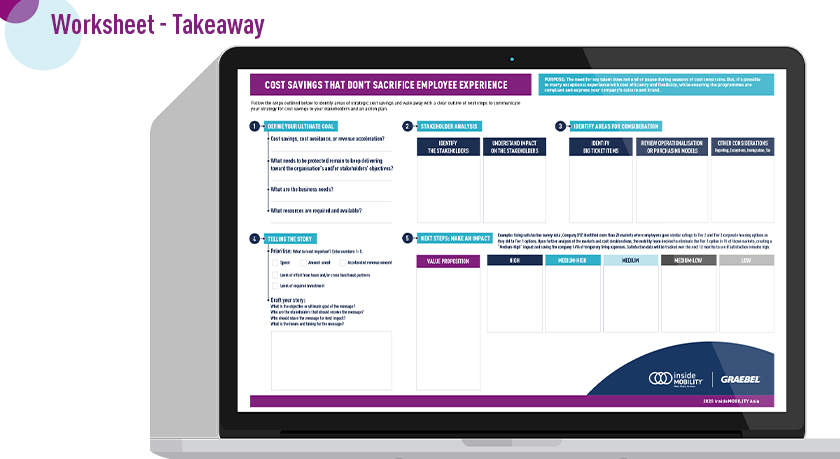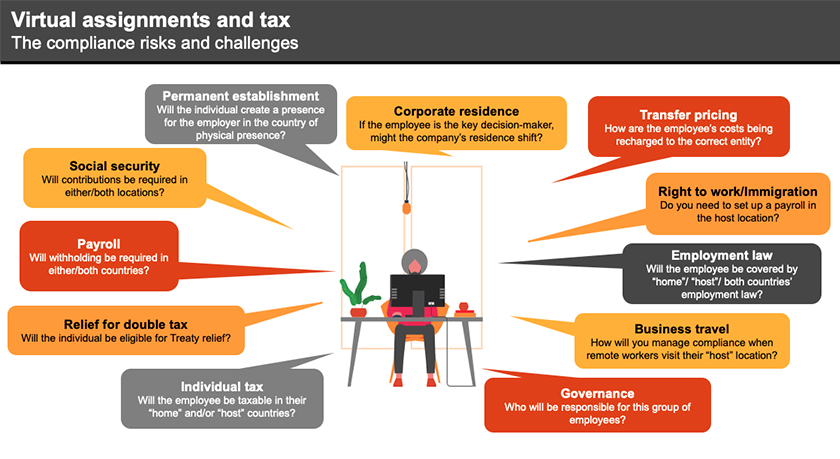
Sharing Insights, Enhancing Experience: insideMOBILITY Asia
Cost savings that don’t sacrifice employee experience
Kicking off day two of insideMOBILITY Asia, Graebel’s Katrin Razzano welcomed attendees to an interactive workshop on how to reduce costs while maintaining an elevated employee experience.
The event began with a poll to ascertain whether participants had been asked by leadership to reduce the costs of their mobility programme. In response, 47% said “yes, I need to reduce costs”, 47% said “not yet, but I expect to be asked”, while 5% said, “no, I don’t expect to be asked”.
As Razzano observed, “we are in the cost-saving season…but the war on talent doesn’t necessarily stop”. The challenge, therefore, is how to reduce mobility expenditure without negatively impacting the employee experience. The answer, said Razzano, is “to get really smart and strategic”, which can be achieved by following Graebel’s systematic approach to this issue:
- Define the ultimate goal: this might include cost savings, cost avoidance, or accelerating revenue, depending on the nature of the company and industry.
- Identify stakeholders: who is impacted by these cost savings; and which stakeholders are involved in the decision-making process?
- Maintain the experience: identify areas where cost efficiencies can be implemented without impact to the employee experience; define what drives satisfaction/dissatisfaction among employees.
- Establish cost savings: prioritise the ideas you have established and the areas where cost savings will be incorporated within the mobility programme based on financial impact, timeline and effort.
Contextualising and communicating these considerations is critical. And within this process, it is important to focus not on the what, but the how. “How are employees receiving the benefit?” asked Razzano. “How are they using it…and what is their evaluation of it?” By following this method of assessment, which is greatly enhanced by data analytics, companies will better understand which benefits/experiences they can and can’t touch.
In the final part of the workshop, participants followed a process map/worksheet (get your copy by joining the insideMOBILITY Slack Community) and shared experiences and insights. Proposed low-impact cost-saving ideas included: renegotiating subscriptions for services made redundant by the pandemic; capping shipping weight allocation for younger assignees; and measuring actual housing charges against utilisation, among others. Presenting change as “improvement based on employee feedback” was also shown to help build a positive cost-saving narrative.
Virtual assignments and tax
Next up, Mark Amatya, Global Mobility Services Director at PwC, and Katrin Razzano delivered a workshop on the challenges and risks linked to virtual assignments (VAs). To introduce the topic, Razzano considered the terminology of virtual assignments, explaining that as yet there are no established definitions of this fairly new and evolving concept. Virtual assignments, she said, overlap with concepts such as work from home (WFH) and work from anywhere (WFA), with the crucial distinction that ‘assignments’ are planned, approved and documented.
During the COVID-19 pandemic, the WFH model has spiralled out of control for many companies, with employees moving cities or even countries under new remote working arrangements. These new legions of WFA nomads have in turn created a host of tax and compliance challenges.
Two quick audience polls confirmed the relevance and urgency of this issue. In the first, 50% said their company was asking or expecting them to own and manage VA and WFH programmes. And in the second, 88% said they were experiencing compliance complications with remote VAs.
On hand to address these issues, Mark Amatya began by reminding participants that huge value can be delivered through VAs and WFH. “The takeaway,” he said, “shouldn’t be that this is too complex.”
Amatya then summarised the VA tax issues companies need to be aware of, as seen below:
The key thing, said Amatya, is not to take a one-size-fits-all approach. It is essential to address VAs on a case-by-case, country-by-country basis. Finally, companies will need to develop new policies and frameworks to enable remote working arrangements. Indeed, giving employees greater flexibility in how and where they work will be particularly important as the war for talent resumes.
Assignment management technologies
In the final session of insideMOBILITY Asia, a panel of speakers, facilitated by Graebel’s Meng Ziang Chy, discussed their experiences of investing in and/or building assignment management technologies.
While data might be the new oil, an opening poll revealed that 42% of respondents don’t have a formal technology platform in place to manage their global mobility programme. Reflecting on the implications of these results, each panel member began by describing the technology platforms they currently use.
The panel consisted of Alf Carlesäter, a senior international human resources leader, Lynn Lee, APAC Head of Global Mobility at Mars, Jessie Li, Global Mobility Manager at Lenovo, and Thorsten Mueller, Global Assignment Manager at Daimler AG.
The panellists then discussed the process of switching platforms, which one described as not just being about tech. “It’s about change management for the entire company,” they said. “It’s a challenging process requiring new behaviours and cultures.” Another panellist concurred, saying that “implementation is never easy”, and that system change must always be aligned with an organisation’s goals.
A second poll revealed that 77% of participants use technology predominantly for internal stakeholder reporting and case management, and just 23% use it as a single platform to provide information on assignees.
The panellists agreed the single platform approach is key to centralising and consolidating data, helping to break down siloes and providing opportunities for better analytics and deeper understanding. Only in this way will global mobility be able to tell a compelling story through data and “get a seat at the table”.
The recording of this panel and other session materials can be found on insideMOBILITY.slack.com.
If you aren’t a member yet, you can request to join here.

